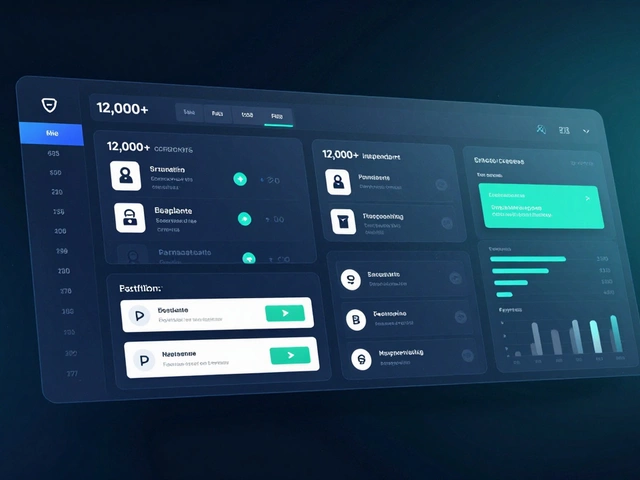
On November 12, 2025, IBM dropped the most significant quantum computing update in years—unveiling two groundbreaking processors that could finally turn decades of theory into real-world power. The IBM Quantum Nighthawk, with 120 qubits and 218 tunable couplers, isn’t just an upgrade. It’s a leap. And it’s scheduled to hit clients’ hands by December 31, 2025. The goal? Quantum advantage—the moment a quantum computer solves a problem no classical machine can touch—in under 18 months. But the real game-changer? IBM Quantum Loon, an experimental chip that’s already decoding quantum errors in under 480 nanoseconds—**a year ahead of schedule**.
How Nighthawk Changes the Game
Nighthawk doesn’t just add more qubits—it rethinks how they talk to each other. Its square lattice architecture with four-degree connectivity lets circuits grow more complex without collapsing under noise. It can run 5,000 two-qubit gates on 120 qubits, a 30% jump over its predecessor, the Heron. That’s not just incremental. It’s the kind of leap that makes researchers sit up straight. By 2028, IBM expects to hit 1,000+ qubits and 15,000 two-qubit gates. That’s the threshold where quantum computers start solving real industrial problems—like simulating new catalysts for carbon capture or optimizing global logistics networks in minutes instead of centuries.
And here’s the twist: IBM isn’t chasing raw qubit counts anymore. It’s chasing useful qubits. The error rates? Still low. The circuit depth? Now viable. The real magic? The Albany NanoTech Complex in New York. IBM moved its entire quantum chip production there, into a 300mm wafer facility that’s doubled development speed and increased chip complexity tenfold. That’s not just a lab upgrade—it’s an industrial-scale pivot. Where competitors were tinkering in clean rooms, IBM is now mass-producing quantum hardware like semiconductors.
Loon: The Error-Correcting Breakthrough
If Nighthawk is the engine, Loon is the brain. This experimental processor is built for error correction using qLDPC (quantum Low-Density Parity-Check) codes—a mathematical framework that’s been theoretical for years. But IBM didn’t just simulate it. They built it. And they ran it. In real time. Under 480 nanoseconds. That’s faster than a blink. Faster than most classical processors can even register the error. This is the missing piece for fault-tolerant quantum computing. Without it, quantum computers are fragile toys. With it? They become tools.
"We’ve cracked the timing problem," said Jay Gambetta, IBM’s director of research. "The path to 2029 isn’t a straight line—it’s a ladder. And Loon is the next rung. We’re the only company building the full stack: hardware, software, fabrication, and error correction, all in parallel. No one else has that.”
What’s more, IBM’s new low-loss wiring layer—designed to connect qubits across modules—works with microwave cables that extend processing power beyond a single chip. Think of it like adding more CPU cores, but for quantum. And they’ve already tested it on AMD FPGA chips, running error-correction algorithms ten times faster than needed. That’s not a prototype. That’s a production-ready signal.
Who’s Competing—and How
Google’s been shouting about quantum advantage since 2019, with its Sycamore chip. But their focus has always been on experimental benchmarks, not commercial systems. Quantinuum, formed from Honeywell and Cambridge Quantum, is betting on trapped ions—more stable, but slower to scale. Meanwhile, startups like Rigetti and IonQ are chasing photonics or neutral atoms. IBM’s strategy? Build the infrastructure first. Scale the ecosystem. Let developers build the apps.
"The hype around quantum computing has been wild," said Sabrina Maniscalco, CEO of Algorithmiq, a Helsinki-based quantum software firm working with IBM. "We’re not here to sell fantasy. We’re here to find the first problems quantum can solve better than classical. Our model challenges every classical algorithm we’ve thrown at it. And the Flatiron Institute’s simulations confirm: it’s classically hard. That’s not marketing. That’s math. But we’re still early. Quantum advantage won’t arrive with a bang—it’ll creep in, quietly, through one useful application at a time."
What Quantum Advantage Really Means
Let’s be clear: quantum advantage doesn’t mean your laptop will be replaced. It means a pharmaceutical company can simulate a protein folding pattern in hours instead of years. It means an airline can optimize flight routes across continents with perfect fuel efficiency. It means breaking current encryption—yes, that’s coming—but also building unbreakable quantum keys.
"AI is changing how we work," noted Semafor in its November 12 coverage. "Quantum computing is changing what’s possible." But the commercial applications? Still unproven. IBM knows this. That’s why they’re launching the IBM Quantum Platform with tools to test quantum advantage on hybrid systems—where quantum processors work alongside classical supercomputers. No one’s waiting for a magic box. They’re waiting for a tool that solves something they can’t solve now.
The Road to 2029: Fault Tolerance and Beyond
By 2029, IBM aims to deliver Starling, its first fully fault-tolerant quantum computer. That means error rates so low, the machine can run complex algorithms indefinitely without crashing. It’s the holy grail. And the pieces are falling into place: the 300mm fab, the Loon processor, the l-couplers for inter-module communication, the new wiring layer—all of it converging.
"We’re not building a better computer," Gambetta added. "We’re building a new kind of computational infrastructure. One that doesn’t replace classical systems—it complements them. That’s quantum-centric supercomputing. And it’s here."
What’s Next?
By Q1 2026, IBM will begin rolling out Nighthawk to enterprise clients via the IBM Quantum Platform. Algorithmiq and other partners will start testing real-world applications in chemistry, finance, and logistics. By mid-2027, IBM expects to demonstrate the first unambiguous quantum advantage in a commercial setting. And by 2029? The world may finally have a machine that doesn’t just compute—it discovers.
Frequently Asked Questions
What does quantum advantage mean for everyday users?
Quantum advantage won’t change your phone or laptop directly. But it will revolutionize industries that affect you: faster drug development for new medicines, optimized energy grids reducing blackouts, and ultra-secure encryption protecting your financial data. The first practical applications will likely be in logistics, materials science, and AI training—areas where even small speedups create massive economic value.
How is IBM’s approach different from Google’s?
Google focused on proving quantum advantage with a single benchmark—Sycamore’s 2019 experiment. IBM is building a full-stack ecosystem: hardware, software, fabrication, and error correction—all designed for commercial scalability. While Google tests theory, IBM is shipping processors to banks, automakers, and research labs. Their goal isn’t just to win a race—it’s to build the infrastructure for the next computing era.
Why is the Albany NanoTech Complex so important?
The Albany NanoTech Complex is one of the world’s most advanced semiconductor facilities. Moving quantum chip production there allowed IBM to use 300mm wafers—industrial-scale silicon manufacturing—instead of lab-sized chips. This doubled development speed and increased complexity tenfold. It’s the difference between hand-crafting a watch and assembling it on a factory line.
Can quantum computers break my passwords?
Yes—eventually. Current public-key encryption (like RSA) is vulnerable to quantum algorithms like Shor’s. But that’s still years away. IBM and others are already developing quantum-resistant cryptography, and NIST is finalizing standards. By the time quantum computers are powerful enough, most critical systems will have transitioned. The real threat is data harvested today being decrypted later—so organizations should start preparing now.
What’s the role of IBM Quantum System Two?
IBM Quantum System Two is the backbone of quantum-centric supercomputing. It integrates scalable cryogenic infrastructure, classical servers, and modular control electronics to let quantum processors work side-by-side with classical HPC systems. This hybrid approach lets users run quantum algorithms only where they’re needed—making quantum computing practical, not just powerful. It’s not a standalone machine—it’s a new computing paradigm.
Is quantum advantage guaranteed by 2026?
No. While IBM is confident, quantum advantage isn’t a switch—it’s a spectrum. Some problems will be solved first, like simulating small molecules or optimizing specific financial portfolios. Others may take longer. Independent verification is critical. That’s why IBM is working with the Flatiron Institute and others to validate results. The tracker they’re launching will let the public see progress in real time—no hype, just data.




